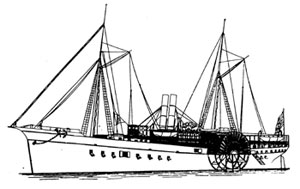
The Fish Block in Waldoboro, largest brick building in the county, burned 1900. The commercial and industrial economic realities of big ship building were reflected in the buildings of Waldoboro, which were, and still are, in contrast to its rural surroundings. Photo: Waldoboro Historical Society |
Whatever the cause, it was the precipitating cause of the Spanish-American War, which began in April, 1898. During 1911-12 her hulk was raised from the bottom of Havana Harbor, towed several miles offshore and sunk with military honors.
But there was another Maine predating all vessels carrying that honor; the one lost in history of the American Civil War. She was a hospital ship and played a major role in the war’s water transportation to the wounded and those soldiers who fell victim to malignant fevers, diarrhea and dysentery. In 1862 the north embraced a large extent of territory and it necessitated the moving of large numbers of men from point to point.
Looking ahead 80 years to World War II, the Army Transport Service operated a total of 24 hospital ships which were manned by civilian crews, employees of the ATS. However, medical staff were Army personnel. These WW II hospital ships operated under the provisions of the Hague Convention X of 1907 which specified identifying markings. These included large illuminated red crosses for aerial visibility at night.
Hospital ships were allowed to carry medical supplies as cargo for the battlefield. Most of them were passenger liners/troopships which were disarmed, repainted and rearranged for hospital use. Six Liberty ships were converted to hospital ships.
However, in the 1860s with immense war casualties, all available ships were used as transports for troops. In order to send a single sick soldier for treatment it was necessary to apply to the quartermaster of the Army, and he usually gave preference to troop movements over transport of the sick and wounded.
That the efforts of the medical department were paralyzed was a fact brought to the notice of the Commanding General by Surgeon Simons, U.S.A. Medical Director, who recommended that a number of boats be taken (chartered) and fitted comfortably with beds cooking apparatus, surgeons and nurses.
The appeal was favorably received and several steamers were chartered and placed under the charge of medical officers. The principal boats employed in eastern waters included the Maine. Her capacity was 300 patients and she carried in 48 trips north, 15,711 patients from medical facilities all along the Middle and Southern Atlantic coast to Philadelphia and New York.
The Maine and other chartered boats were actually under the immediate direction of the Quartermaster General and when they were turned over to medical authorities they were destitute of all conveniences. There were no beds nor food aboard, let alone mattresses, bedding, medicine or surgical appliances. Outfitting became the hurried job of the Sanitary Commission.
Not all hospital ships were chartered bare and sparse. Perhaps the most perfect of hospital ships was the steamer D.A. January. She was purchased on April 1, 1862 and placed under orders of Assistant Surgeon A.H. Hoff, U.S.A. A side-wheel steamer, she was built at Cincinnati in 1857. She was 4,850 tons burden, 238-feet in length with two high-pressure engines with cylinders 22-inches in diameter and 7 feet stroke.
Her whole deck was converted to one spacious ward. Large windows were placed on all sides of the ward. There was a nurse’s station, dining room, bathroom and special diet kitchen. Aft there was a drug shop, steward’s room and linen room on one side; and an operating room in the center. Water was supplied from a large water tank on the hurricane deck filled by steam power. Pipes ran from the hurricane deck to two large ice chests. In these chests were two large “worms” through which the water fed the faucets.
The Maine by comparison was a sparse barge although her patient transport was remarkable.
There were plenty of bureaucratic spats during the Civil War. Even for the hospital ships. As they were technically under the Quartermaster General as “loans” he frequently requested some of them be returned for troop transport.
The Acting Surgeon General, J.K. Bames, did not agree and claimed that such steamers were assigned to the Medical Department and not as temporary transports. He also blasted off a letter to the Secretary of War on January 3,1865 saying, “Hospital ships have been fitted at great expense and some dispatched to meet General Sherman’s army upon notification of its arrival at Savanna. To divert them to other purposes entirely cripples this Department in its efforts to provide properly for the sick and wounded, and subordinates all its interests to the caprice or whims of local commanders.”
On February 8, 1865, a response from E.D. Townsend, Assistant Adjutant General, War Department, came in the form of General Order No. 18: “Hospital transports and hospital boats, after being properly assigned as such, will be exclusively under the control of the Medical Department, and will not be diverted from their special purposes by orders of local or department commanders, or of officers of other staff departments.”
From then on and from those early hospital ships and boats like the Maine the singular reputation of specialized ships to carry and care for the wounded and sick of all wars became a part of the naval history of America — and the State of Maine.
|





